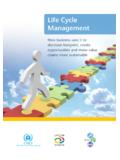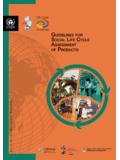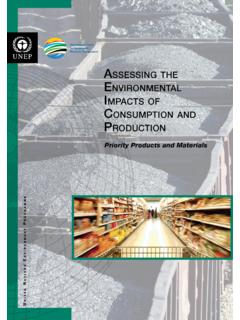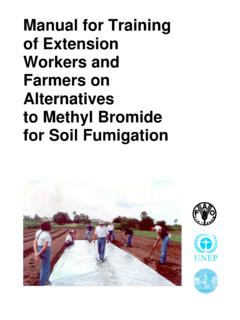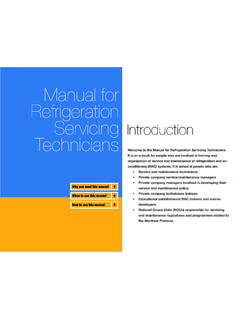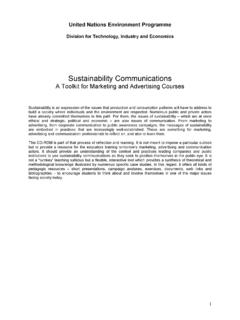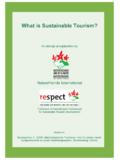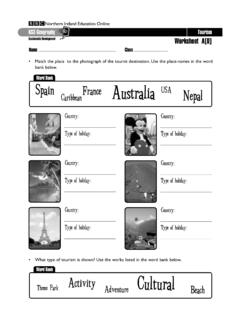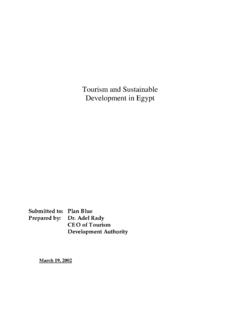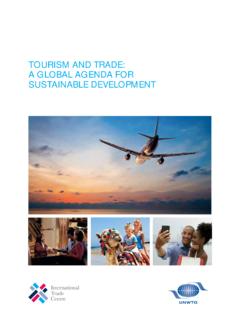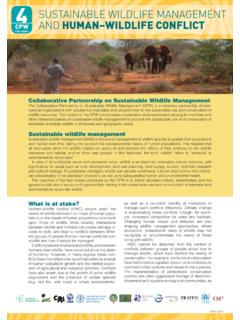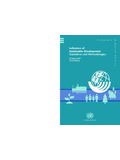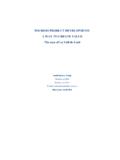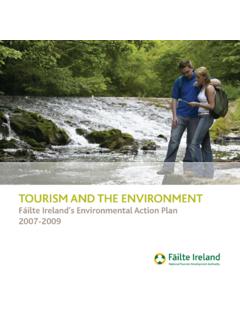Transcription of #JPMPHJDEWFSTJUZ $PNNVOJUZ 8FMMCFJOH
1 making tourism more SUSTAINABLEA Guide for Policy MakersUnited Nations Environment ProgrammeDivision of Technology, Industry and Economics39-43 Quai Andr Citro n75739 Paris CEDEX 15, FranceTel: +33 1 44371450 Fax: +33 1 44371474E-mail: World tourism OrganizationCapit n Haya 42 28020 Madrid, SpainTel: +34 91 567 81 00 Fax: +34 91 571 37 33E-mail: QualityCommunity Wellbeing Biological Diversity Economic Viability Local Control Physical Integrity Environmental PurityLocal Prosperity Visitor FulfillmentCultural Richness Resource EfficiencySocial Equity iiMAKING tourism more SUSTAINABLEiiiMAKING tourism more sustainable ForewordForewordInternational tourist arrivals have almost quadrupled over the past 30 years and domestic tourism has also intensified in most developed and newly industrialized countries.
2 At the same time, tourist movements have spread geographically to reach practically all countries of the globe, becoming for many of them an important economic sector in terms of income generation, foreign exchange earnings and employment about sustainability issues which referred originally to the natural environment but now also covers the social, economic and cultural spheres as well as the built environment also developed significantly over those 30 years. Today, most governments, international development agencies, trade associations, academic institutions and non-governmental organizations acknowledge that, without sustainability, there cannot be development that generates benefits to all stakeholders, solves serious and urgent problems such as extreme poverty, and preserves the precious natural and man-made resources on which human prosperity is tourism sector could not remain indifferent to the sustainability challenge of our times.
3 This is why the World tourism Organization (WTO) focuses its advisory and technical assistance services on policies, development guidelines, management techniques and measurement instruments that allow national and local governments, as well as the tourism industry, to incorporate sustainability principles into their decision making process and day-to-day operations. This is why the United Nations Environment Programme (UNEP) has initiated a programme that aims at integrating environmental sustainability into decision making in the tourism industry and into consumers purchasing choices, by disseminating technical know-how and building business networks to catalyse sustainability in the tourism sector.
4 making tourism more sustainable : a Guide for Policy Makers builds on UNEP and WTO s previous work on different aspects of sustainability, undertaken over the past ten or so years. This is the first time that the two organizations have combined their input in a joint effort to condense all aspects of the sustainability of tourism into a single publication. In addition to earlier work by WTO and UNEP, an extensive research survey was undertaken within WTO Member States, in 2003 and 2004, to identify specific policies and tools applied in their territories that had effectively contributed to making their tourism sector more sustainable .
5 The conclusions drawn and the policies and tools recommended in this Guide are therefore based on real cases, collected from around the world, that have proven to be effective and successful in achieving the aims of sustainable of the Guide, which provides a blueprint for governments to formulate and implement sustainable tourism policies, was one of the most important building blocks in the partnership between UNEP and WTO, also benefiting, in this case, from a Ford Foundation national or local government will surely need to select those policies and tools considered most suitable to its particular circumstances, and adapt them to the conditions prevailing in its country, region or local jurisdiction.
6 IvMAKING tourism more SUSTAINABLEThe Guide defines what sustainability means in tourism , what are the effective approaches for developing strategies and policies for more sustainable tourism , and the tools that would make the policies work on the ground. It shows clearly that there is no one-fits-all solution to address the question of sustainability in tourism development. It does, however, highlight one key universal message: to succeed in making tourism more sustainable it is crucial to work hand in hand with all relevant stakeholders, within and outside government. Therefore although the report is aimed mainly at governments public authorities at all levels are encouraged to disseminate its contents to those private and non-governmental organizations that have an interest in ensuring the long-term success of the tourism sector.
7 Especially the wide range of tourism businesses and their trade long standing partnership between the WTO and UNEP is a living example of the need for and benefits of Frangialli Klaus ToepferSecretary General Executive DirectorWorld tourism Organization United Nations Environment Programme ForewordvMAKING tourism more SUSTAINABLEA cknowledgementsConception, technical editing and supervision Giulia Carbone (UNEP) and Eugenio Yunis (WTO)Principal consultant Richard Denman, The tourism Company, United KingdomEnglish language editor Geoffrey BirdDesign The Graphic EnvironmentUNEP and WTO are grateful to the following for their inputFor contribution to the case studies: Australia: Alice Crabtree, David Morgans Bulgaria: Kamelia Georgieva Costa Rica: Amos Bien Egypt: Bill Meade, Ahmed Hassan Ghana: Wouter Schalken Mexico: Liliana Garcia Huerta Kaikoura, New Zealand: Kirsty Quickfall, Ian Challenger South Africa: Anna Spenceley, Johann Kotze Calvia, Spain: Rachel Dodds Scotland, UK.
8 Sandy Dear, Jon ProctorAdditional contributions to the text: The International Ecotourism SocietyInformation on specific examples or topics:Sylvie Barrere, Dirk Belau, Sylvie Blangy, Ralf Buckley, Kelly Bricker, Hugh Cresser, John Downes, Andy Drumm, Steve Edwards, Enzo Finocchiaro, Miriam Geitz, Douglas Hainsworth, Herbert Hamele, Moosa Zameer Hassan, Marion Hammerl, Veronika Holzer, Martha Honey, Maxi Lange, Marcel Leijzer, Manoa Malani, Marie Louise Mangion, Salvador Semitier Marti, Rabi Jung Pandey, Anna Quartucci, Laure Sagaert, Jennifer Seif, Mercedes Silva, Murray Simpson, Claire Stott, Richard Tapper, Jean-Paul Teyssandier.
9 Yara and WTO are grateful to the Ford Foundation for its financial support which has made this project tourism more SUSTAINABLEviiMAKING tourism more SUSTAINABLET able of ContentsFOREWORD iiiACKNOWLEDGEMENTS vTABLE OF CONTENTS viiLIST OF ABBREVIATIONS ixINTRODUCTION 11 tourism AND SUSTAINABILITY 7 tourism : dynamism and growth 8 sustainable development: an evolving agenda 8 tourism and sustainable development: a special relationship 9 making all tourism more sustainable 11 Key challenges for more sustainable tourism 12 International recognition 14 Guiding principles and approaches 15 An agenda for sustainable tourism 18 Governments.
10 The market and the industry s view 20 The crucial role of government 232 POLICY IMPLICATIONS OF A sustainable tourism AGENDA 25 Economic Viability 26 Local Prosperity 28 Employment Quality 30 Social Equity 32 Visitor Fulfilment 33 Local Control 34 Community Wellbeing 36 Cultural Richness 38 Physical Integrity 39 Biological Diversity 41 Resource Efficiency 44 Environmental Purity 463 STRUCTURES AND STRATEGIES 49 Structures for working together 50 Interrelated national strategies 53 Integrating national and local level strategies 564 SHAPING sustainable tourism 59 Developing a sustainable tourism strategy 60 Determining the level and nature of tourism 63 Influencing tourism development 66 Influencing the operation of tourism enterprises 68 Influencing visitors promoting sustainable consumption 69 Table of ContentsviiiMAKING tourism more SUSTAINABLE5 INSTRUMENTS FOR more sustainable tourism 71 Measurement instruments 72 Sustainability indicators and monitoring 72 Identifying the limits of tourism 75 Command and control instruments 78 Legislation.
